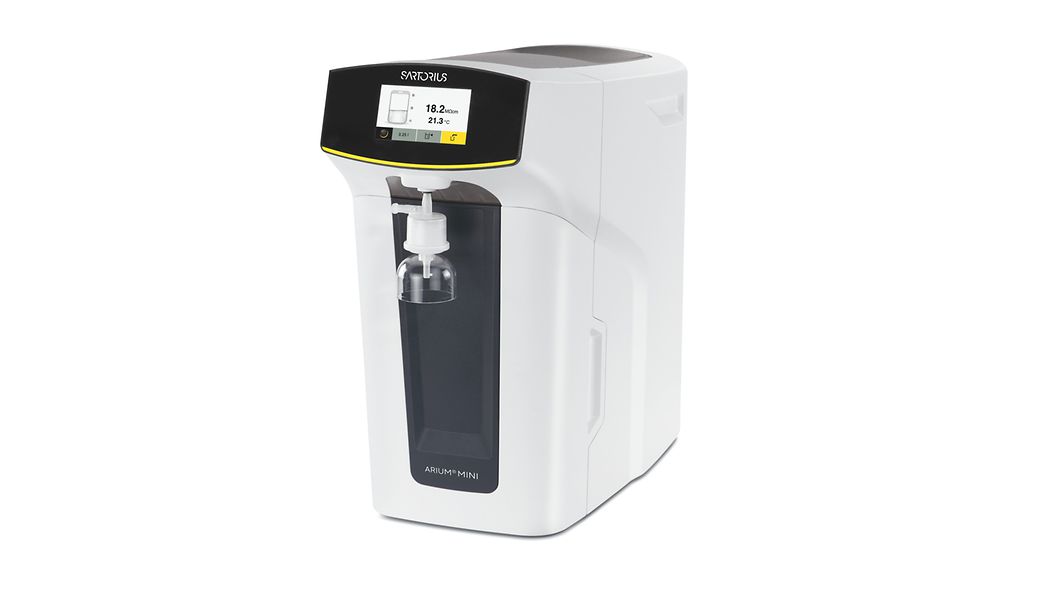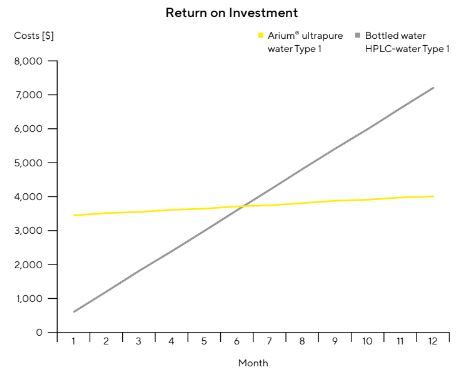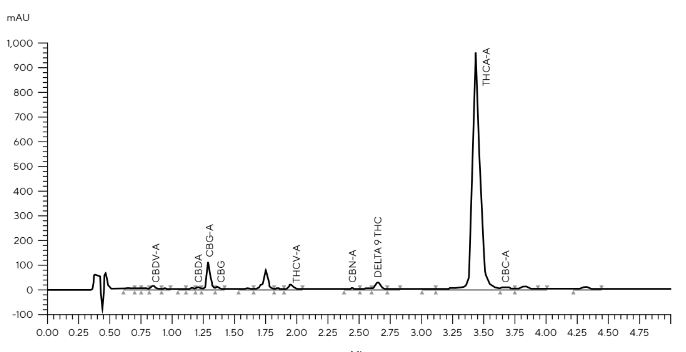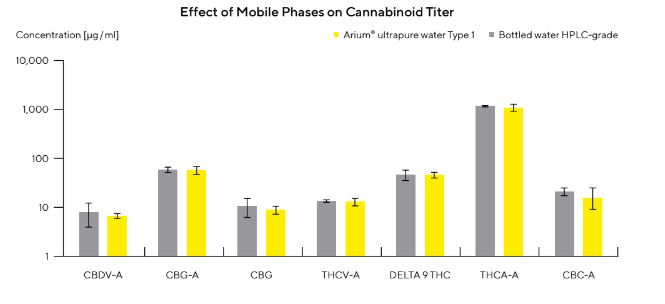Blog Standard

Optimizing Laboratory Water Solutions for HPLC-Based Cannabis Testing
High-performance liquid chromatography (HPLC) and ultra-high-performance liquid chromatography (UHPLC) demand consistently high laboratory water quality, especially during mobile phase preparation. The purity of water used directly impacts instrument sensitivity, reliability, and accuracy—particularly in critical applications like cannabis potency testing.
Traditionally, laboratories have relied on HPLC-grade bottled water for such purposes. However, generating ultrapure water in-house using a robust water purification system offers a cost-effective and sustainable alternative. This study explores the use of the Arium® mini-plus in-house water purification system (producing ASTM Type 1 water) compared with commercial HPLC-grade bottled water for cannabinoid analysis in cannabis samples.

Arium® Mini Ultrapure Water Systems
Both water sources were used to prepare aqueous mobile phases containing 5 mM ammonium formate and 0.1% formic acid. These mobile phases were then evaluated through HPLC analysis of cannabis extracts to assess the effectiveness of each water type in terms of analyte quantification and interference.
Materials and Methods
Cannabinoid reference standards and the internal standard (ISTD) phencyclidine (PCP) were obtained from Cerilliant (Round Rock, TX) as individual substances. Ricca ACS Reagent Grade and HPLC-grade water were sourced from Quartzy, while ultrapure water ASTM Type 1 was produced using the Arium® mini plus system on the day of use. HPLC analysis was performed using a Shimadzu Nexera-i LC2040L 3D Plus system, equipped with a Restek Rapture ARC-18 column (100 mm×3.0 mm ID×1.80 μm) and a Restek UltraShield pre-column filter (0.2 μm frit), set at 30°C. The system operated in isocratic mode with a mobile phase of 25% aqueous (Water, 5 mM ammonium formate, 0.1% formic acid) and 75% organic (Acetonitrile, 0.1% formic acid) at a flow rate of 1 mL/min. A sample volume of 1 μL was injected and detected using photodiode array detection across the 190-400 nm wavelength range.
A stock solution containing 17 cannabinoids and the ISTD at 100 μg/mL in methanol was prepared. This solution was serially diluted to create calibrators. Another stock solution of the same cannabinoids was prepared for use as a positive control. A 4-constituent control from a different reference standard source was included as a high control. A matrix methanol solution was prepared by grinding 20 mg of stinging nettle leaf (Urtica dioica) and extracting it with 20 mL methanol, followed by sonication, vortexing, centrifugation, and filtration, which was stored for calibrators, controls, and blanks.
Cannabis samples were processed by placing 1-2 grams of cannabis in a 50 mL centrifuge tube with a grinding ball and freezing it for 1 hour. The tube was then placed on a Geno Grinder for 1 minute at 1600 rpm. A 0.2-gram portion of ground cannabis was placed in a separate tube with 20 mL methanol for extraction, which was repeated three times using vortexing for 1 minute and sonication for 5 minutes. A 1 mL aliquot was removed, filtered, and ultra-centrifuged for 5 minutes at 14,000 rpm. After filtering, 100 μL of undiluted and diluted samples were added to 150 μL auto-sampler vials, internal standard was added, and the samples were analyzed by HPLC.

Figure 1: Comparison of expenses between in-house produced Arium® water Type 1 (ultrapure water) and bottled water (HPLC grade) calculation based on following assumptions two liters water consumption per working day, 20 working days per month, Arium® mini systems list price=$3,400, annual Arium® mini consumables list price=$600 and costs bottled water HPLC grade=$15/liter.
A calibration curve, blanks, and controls were prepared to determine acceptance and tolerance limits. The cannabis samples were analyzed against the calibration curve’s linear dynamic range and reported in μg/mL. A total of 60 samples were tested, with each water type analyzed using a blank, positive control, and cannabis sample, repeated 10 times across the 17 cannabinoids (as shown in Table 1).
| Mobile Phase | Samples | Replicates |
|---|---|---|
| Bottled water | Blank | 10 |
| Bottled water | Positive Control | 10 |
| Bottled water | Cannabis Sample | 10 |
| Arium® water | Blank | 10 |
| Arium® water | Positive Control | 10 |
| Arium® water | Cannabis Sample | 10 |
Table 1: Summary of analytical runs. Bottled water=bottled water HPLC-grade, Arium® water=Arium® ultrapure water type 1.

Figure 2: Cannabis samples were quantitatively analyzed using a set of 17 different cannabi noids Only seven analytes (CBDV-A, CBG, THCV-A, DELTA 9 THC, THCA-A, CBC-A) were above the LOQ and were subsequently compared.
Results and Discussion
Figure 3A demonstrates that all positive controls, regardless of the water source, were quantified within the expected range. No interfering peaks were detected in the blanks (Figure 3B), confirming the purity of both bottled and ultrapure water.
Among the 17 tested cannabinoids, 7 analytes (CBDV-A, CBG-A, CBG, THCV-A, Delta-9 THC, THCA-A, and CBC-A) were consistently above the limit of quantification (LOQ) and used for further comparison. Quantitative analysis showed no statistically significant differences in analyte concentration when using Arium® ultrapure water compared to commercial bottled water (Figure 4). These findings validate the use of in-house water purification systems for critical lab water solutions in regulated environments.

Figure 3A: All positive controls quantify within the expected range.
Figure 3B: No interfering compounds were detected We used two different water sources 'HPLC grade bottled water' and 'ultra-pure Arium® water Type 1' to prepare the mobile phase (isocratic 25% water, 75% acetonitrile, 0.1% formic acid) for cannabinoid analysis using HPLC. Both water sources are pure and suitable for HPLC in cannabis analytics.

Figure 4: No significant differences in cannabis quantities were found by using two different water sources for mobile phase. The bars show concentration of seven cannabinoids analyzed by HPLC using Arium water type 1 (yellow bars) as mobile phase compared to HPLC-grade bottled water (gray bars)
Conclusion
This study confirms that laboratory-generated ultrapure water from the Arium® mini-plus water purification system is comparable in performance to commercial HPLC-grade bottled water for mobile phase preparation in cannabis potency testing using HPLC.
Implementing an in-house filtration water system offers significant advantages:
- Maintains high laboratory water quality
- Reduces reliance on single-use bottled water
- Enables cost savings, with amortization typically within six months for labs requiring just 2 liters of ultrapure water per day
For laboratories conducting water analysis, cannabinoid quantification, or any HPLC-based application, adopting a modern water purification system ensures consistent results, operational efficiency, and long-term value.
Inkarp Instruments is proud to be India's premier distributor and trusted service provider for Sartorius products. Committed to innovation and excellence, Inkarp delivers cutting-edge scientific equipment and dependable support to researchers throughout the country.
Reference : Sartorius

